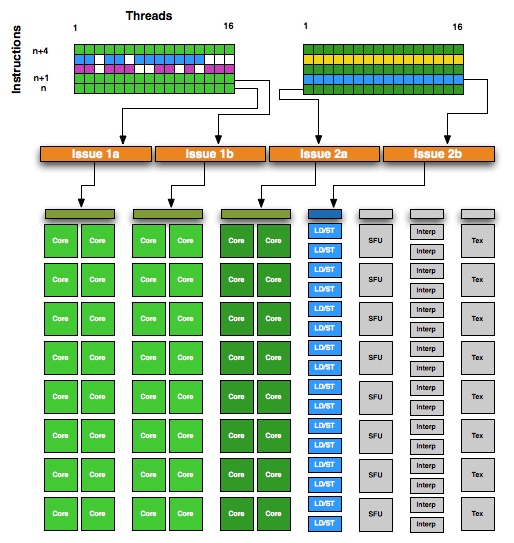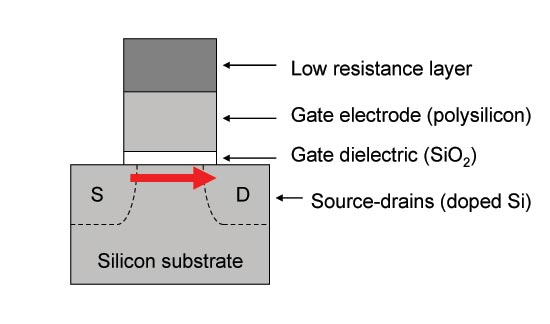NVIDIA's GeForce GTX 560 Ti: Upsetting The $250 Market
by Ryan Smith on January 25, 2011 9:00 AM ESTThe GF104/GF110 Refresher: Different Architecture & Different Transistors
For all practical purposes GF100 is the Fermi base design, but for sub high-end cards in particular NVIDIA has made a number of changes since we first saw the Fermi architecture a year and a half ago. For those of you reading this article who don’t regularly keep up with the latest NVIDIA hardware releases, we’re going to quickly recap what makes GF114 and GTX 560 Ti different from both the original GF100/GF110 Fermi architecture, and in turn what makes GF114 different from GF104 through NVIDIA’s transistor optimizations. If you’re already familiar with this, please feel free to skip ahead.
With that said, let’s start with architecture. The GF100/GF110 design is ultimately the compute and graphics monster that NVIDIA meant for Fermi to be. It has fantastic graphical performance, but it also extremely solid GPU computing performance in the right scenarios, which is why GF100/GF110 is the backbone of not just NVIDIA’s high-end video cards, but their Tesla line of GPU computing cards.
But Fermi’s compute characteristics only make complete sense at the high-end, as large institutions utilizing GPU computing have no need for weaker GPUs in their servers, and in the meantime home users don’t need features like ECC or full speed FP64 (at least not at this time) so much as they need a more reasonably priced graphics card. As a result only the high-end GF100/GF110 GPUs feature Fermi’s base design, meanwhile GF104 and later use a tweaked design that stripped away some aspects of Fermi’s GPU compute design while leaving much of the graphics hardware intact.
NVIDIA GF104 SM

With GF104 we saw the first GPU released using NVIDIA’s streamlined Fermi architecture that forms the basis of GF104/GF106/GF108/GF114, and we saw a number of firsts from the company. Chief among these was the use of a superscalar architecture, the first time we’ve seen such a design in an NVIDIA part. Superscalar execution allows NVIDIA to take advantage of Instruction Level Parallelism (ILP) – executing the next instruction in a thread when it doesn’t rely on the previous instruction – something they haven’t done previously. It makes this streamlined design notably different from the GF100/GF110 design. And ultimately this design is more efficient than GF100/GF110 on average, while having a wider range of best and worst case scenarios than GF100/GF110, a tradeoff that doesn’t necessarily make sense for GPU computing purposes but does for mainstream graphics.
Meanwhile in terms of low-level design, starting with GF110 NVIDIA began revising the low-level design of their GPUs for production purposes. NVIDIA’s choice of transistors with GF10x was suboptimal, and as a result they used leaky transistors in functional units and parts thereof where they didn’t want them, limiting the number of functional units they could utilize and the overall performance they could achieve in the power envelopes they were targeting.
For GF110 NVIDIA focused on better matching the types of transistors they used with what a block needed, allowing them to reduce leakage on parts of the chip that didn’t require such fast & leaky transistors. This meant not only replacing fast leaky transistors with slower, less leaky transistors in parts of the chip that didn’t require such fast transistors, but also introducing a 3rd mid-grade transistor that could bridge the gap between fast/slow transistors. With 3 speed grades of transistors, NVIDIA was able to get away with only using the leakiest transistors where they needed to, and could conserve power elsewhere.

A typical CMOS transitor: Thin gate dielectrics lead to leakage
GF110 wasn’t the only chip to see this kind of optimization however, and the rest of the GF11x line is getting the same treatment. GF114 is in a particularly interesting position since as a smaller GPU, its predecessor GF104 wasn’t as badly affected. Though we can’t speak with respect to enabling additional functional units, at the clockspeeds and voltages NVIDIA was targeting we did not have any issues with the stock voltage. In short while GF100 suffered notably from leakage, GF104 either didn’t suffer from it or did a good job of hiding it. For this reason GF114 doesn’t necessarily stand to gain the same benefit.
As we touched on in our introduction, NVIDIA is putting their gains here in to performance rather than power consumption. The official TDP is going up 10W, while performance is going up anywhere between 10% and 40%. This is the only difference compared to GF104, as GF114 does not contain any architectural changes (GF110’s changes were backported from GF104). Everything we see today will be a result of a better built chip.










87 Comments
View All Comments
heflys - Tuesday, January 25, 2011 - link
Well, at least they have the distinction of being the only site (that I've seen thus far) to say the 560 is faster than the 6950. It's just laughable, IMHO, that they'd feature several titles known to favor Nvidia (with results showing the 560 beating top-tier AMD cards), yet still reach the conclusion that the 560 is "faster" at stock.I've been slowly taking AT less and less seriously.........Thank goodness for their benching charts.
ritalinkid18 - Tuesday, January 25, 2011 - link
One thing I've noticed about the comments so far... every single person disagreeing with the conclusion ends up agreeing conclusion in their reasoning.i.e. "what games you play"
"The deciding factor seems to come down to just how much to value noise and cooling (560) versus power consumption (6950), what games you play, and whether you’re currently invested in the NVIDIA (CUDA, 3D Vision) or AMD (Eyefinity) ecosystem."
heflys - Tuesday, January 25, 2011 - link
Well, in that case, Anand is contradicting themselves.....Since (using that logic) the 560 wouldn't be "a bit faster" in performance, or have the overall edge. In other words, they wouldn't be able to conclude which card is "faster." They're conclusion of "faster" is based on their own benchmarks.Ryan Smith - Tuesday, January 25, 2011 - link
To be clear, on my master charts the GTX 560 Ti has an average of a 2% performance lead over the 6950 1GB at 1920, and a 10% performance lead at 1680. This doesn't preclude the fact that performance varies wildly by game; it only means that on average the GTX 560 Ti was faster.heflys - Tuesday, January 25, 2011 - link
Not surprising looking at the results in HAWX, Civ 5 and Dirt 2.Touche - Wednesday, January 26, 2011 - link
That's just a terrible way to reach a performance conclusion, in so many ways. Then again, the number of people taking Anandtech's (GPU) reviews seriously is smaller every day. I miss the years it was practically my homepage and main reference point.dananski - Tuesday, January 25, 2011 - link
I was puzzled by your comment (and others'). It seemed to me that while the 560 and 6950 1GB were changing relative position in the charts, the 560 really wins hard when it does win, so it would come out slightly above the 6950 on average.Plus, I'd prefer a card that does well every time (the 560) but gets slightly beaten occasionally, rather than a card that does well most of the time but really falls behind in certain games.
heflys - Tuesday, January 25, 2011 - link
People are always jaded when it comes to games that show a significant bias for a particular manufacturer. In the case of Civ 5, HAWX and Dirt 2 (as of late); these titles favor Nvidia products. If you look at the benches, the 560 is even beating a 6970 in some instances.qwsa - Tuesday, January 25, 2011 - link
Anandtech has always had their nose up Nvidia and intels ass so no surprise there, but what a lousy conclusion to an awfull review. Apparently Anandtechs efforts to find good writers were in vane.silverblue - Tuesday, January 25, 2011 - link
Please... let's not start this again...